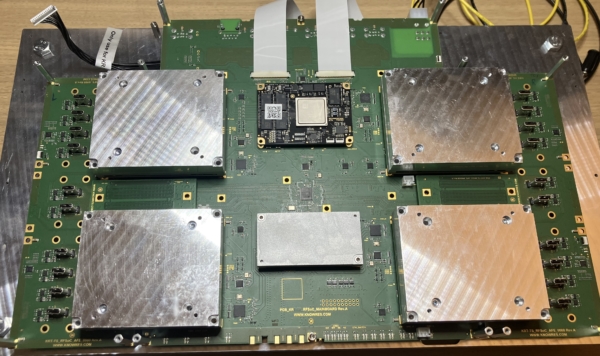Project Description
To automate the testing of a very complex RFSoC carrier design, which took a skilled engineer two man-days and a small pile of costly test equipment to complete manually, we developed a capable test system that cuts testing time down to less than 30 minutes. It also records all results automatically in our test database, ready for retrieval to populate a comprehensive test report.
The test system relies on not one, but four of our KRM-4ZU47DR RFSoMs (based on a Xilinx XCZU47DR RFSoC) to stimulate and measure the RF response of the DUT, and one KRM-3ZU4CG FPGA module as the test system master. The master SoM coordinates the test sequence, including power cycles, code loading, current monitoring, and all communications interfaces. It also interfaces with our test database where all the results are stored, drives the label printer, and gets operator prompts and feedback via the QR-code scanner. An Ethernet switch SoM provides the data connectivity between the five FPGA modules.
An interested observer may have noticed the many USB-C connectors on each side of the assembly. Yes, we use those to connect the differential RF signals from the DUT (via disposable adapter pods) to the stimulus DACs and measurement ADCs of the test RF SoMs. How do we get away with that ? Simple, we use our 40GHz, 4-port Rohde & Schwarz VNA to characterize the performance of the (high quality) USB-C cables and de-embed. This pragmatic approach lowers the cost of each system’s cabling (yes, only cabling) by about € 3500.00 compared to a dedicated twin-ax system. Despite its lower cost, it still provides reliable, consistent measurements up to 5GHz, which is more than sufficient for this application.
The test system consists of many additional adapter boards, clock sources, and measurement adapters that allow it to be reconfigured to test all aspects of a complex custom designed assembly. With this system those tests can be completed in a time span that makes it economically viable to fully characterize all 16RF channels of each unit that is produced at KR.
The system is in active use but is also undergoing further upgrades and adaptations so that we can utilize it for an increasing range of RF SoM-related products here at Knowledge Resources.


